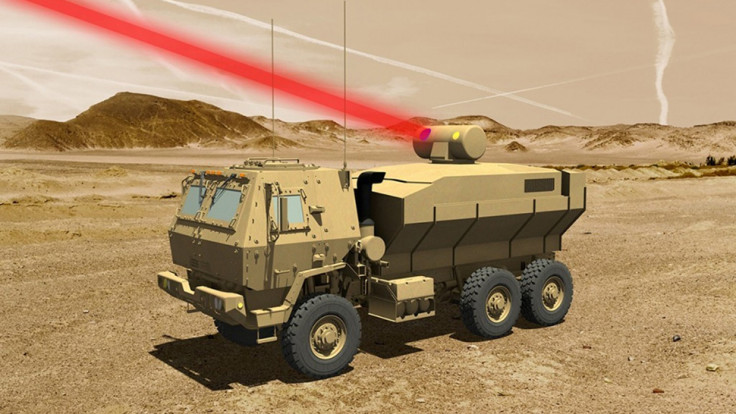US Army to deploy powerful 60kW solid-state laser weapon that can destroy targets a mile away
Lockheed Martin's record-setting truck-mounted fibre laser weapon will soon be used by the US Army.

Lasers will soon become a key instrument of war – the US Army is to test a revolutionary fibre laser beam developed by defence firm Lockheed Martin that is so powerful it can hit targets located well over a mile away within seconds.
The US Army will be testing out a new 60kW combined beam laser weapon that is small enough to be mounted onto its High Energy Laser Mobile Test Truck (HELMTT) over the next few months, in partnership with Lockheed Martin.
Back in March 2015, Lockheed Martin showcased Advanced Test High Energy Asset (ATHENA), a ground-based system featuring a 30kW single-mode fibre-optic laser that can be used to disarm targets in a non-lethal way.
The laser used a technique called spectral beam combining, which takes multiple fibre laser modules and directs them at the same point to form a single, powerful beam.
What made the demonstration particularly interesting was the fact that it could disable a stationery truck by using the laser burn through the engine manifold. The beauty of the system is that it didn't cause the truck's engine to explode – it just made it stop working.
Fast forward to 2017, and the defence contractor says that not only has it set a new world record for a 58kW fibre solid-state, combined beam laser beam, but it is also going to ship it out to the US Army, which wants to mount the lasers onto trucks.
"The inherent scalability of this beam combined laser system has allowed us to build the first 60kW-class fibre laser for the US Army," said Dr Robert Afzal, a senior fellow for the Laser and Sensor Systems division at Lockheed Martin.
"We have shown that a powerful directed energy laser is now sufficiently light-weight, low volume and reliable enough to be deployed on tactical vehicles for defensive applications on land, at sea and in the air."
A breakthrough for solid-state lasers
The defence contractor says that its latest laser beam is "near diffraction limited", which means that it comes close to the physical limits for focusing energy toward a single, small spot. Tests have also shown that the laser weapon is able to convert 43% of the available electricity powering it directing into the laser beam emitted, which is very high for a solid-state laser.
The new solid-state system is a breakthrough for laser technology, as it is much safer than chemical lasers, which require volatile chemicals to be combined to produce powerful laser beams, such as the US Army's current Tactical High Energy Laser – developed by Northrop Grumman. But most importantly, the fibre laser is scalable, meaning it could be deployed on other military vehicles and perhaps even drones in the future.
In 2014, the US Defense Department posted a job opportunity on the US government's federal business opportunities websites, seeking a laser weapon that would be able to produce "a minimum of 50 kilowatts of output power".
The ad specified that the laser weapon would need to be able to maintain this level of output for 60 seconds and be able to regenerate in less than 10 minutes. The laser's wavelength also needed to be between 1,060 and 1,80 nanometres, with 90% of the power contained within a 2nanometre wavelength region. The laser would also need to be small enough to be carried around in an 8x53in flatbed trailer.
© Copyright IBTimes 2025. All rights reserved.






















